- Partner ecosystems foster faster and more effective co-marketing and co-selling.
- Partner ecosystems present another route to customers and more sales.
- Partner ecosystems create more complete solutions through purpose-built integrations.
- Partner ecosystems integrate the partner program with the provider company.
- Partner ecosystems improve partner experience (PX).
What is a Partner Ecosystem & Why Do Channel Partner Programs Need Them?
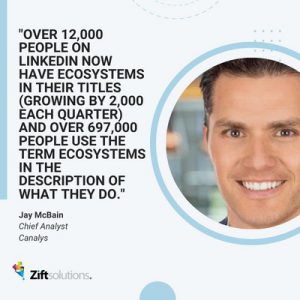
“Partner ecosystem” is a popular topic of conversation in the channel lately. You’re hearing about it more for good reason – almost a third of total global sales are predicted to come from ecosystems by 2025, according to McKinsey. Ecosystems are also expected to create $100 trillion of value for business and wider society by 2027, according to Accenture.
Global technology giants are adapting to the growth in partner ecosystem models. Jay McBain, Chief Analyst for technology market analyst firm Canalys and one of the channel’s foremost experts on partner ecosystems, points to tangible organizational changes these companies are making. “When looking at the people and organizational elements of new channel models, we have seen the largest technology companies make significant changes. Last year, Microsoft replaced its top channel executive with an ecosystem leader. AWS, Google, IBM and others have followed in the last few quarters. Even smaller vendors, such as Sage, have followed suit. In fact, over 12,000 people on LinkedIn now have ecosystems in their titles (growing by 2,000 each quarter) and over 697,000 people use the term ecosystems in the description of what they do.”
The rise in partner ecosystems is evident, but why do partner programs need to develop a partner ecosystem? To find out the answer, we interviewed seven channel leaders for insight into why partner programs would benefit from an ecosystem model. Our expert panelists include:
- Jay McBain, Chief Analyst for technology market analyst firm Canalys
- Karin Fields, Chief Executive Officer at FMX Tech
- Tamara Prazak, Senior Director of Channel Sales, West Region for secure access provider Appgate
- Kristine Stewart, Founder and CEO for channel consultancy The Lexington Group
- Greg Plum, Director/Principal – North America for fractional partner leadership company PartnerReady
- Khali Henderson, Senior Partner for channel consultancy and technology marketing firm BuzzTheory
- Heather Tenuto, Chief Revenue Officer for partner relationship management (PRM) and channel management platform provider Zift Solutions
Want to skip ahead? Check out five reasons your channel partner program needs a partner ecosystem:
- Partner Ecosystems Foster Faster & More Effective Co-Marketing & Co-Selling
- Partner Ecosystems Present Another Route to Customers & More Sales
- Partner Ecosystems Create More Complete Solutions Through Purpose-Built Integrations
- Partner Ecosystems Integrate the Partner Program with the Provider Company
- Partner Ecosystems Improve Partner Experience (PX)
What is a Partner Ecosystem?
 We surveyed our panel to define a partner ecosystem. The answers circle around the same ideas but from different perspectives about who owns the ecosystem relationships and various analogies for how the ecosystem operates.
We surveyed our panel to define a partner ecosystem. The answers circle around the same ideas but from different perspectives about who owns the ecosystem relationships and various analogies for how the ecosystem operates.
Appgate’s Tamara Prazak describes a partner ecosystem as “the next iteration of a channel program, ensuring vendors are broadening their reach beyond traditional channel programs targeting resellers and referral partners to expand to include influencers, marketplaces, MSPs [managed services providers] and partners who do not want to be compensated for recommending your solution.”
Karin Fields of FMX Tech says, “The partnership ecosystem is a group of well-developed relationships that enable a partner to walk into any customer and be able to support all of the customer’s needs.”
Fields compares this function to being a general contractor building a house. “The customer wants a specialized roof, [and] the general contractor goes to his/her relationships and finds someone he/she has already worked with and trusts to help deliver the experience the customer wants. Let’s say the customer wants a specific material for the roof. Once again, the general contractor goes to his/her contacts and finds the best supplier offering the product the customer wants at the best quality and price.”
The Lexington Group’s Stewart characterizes the partner ecosystem as a community of all the companies that play a role in delivering business outcomes to customers. She points out this network is extensive, “…this can include all the technology companies that you integrate with to build your solutions, the places they go to get information, the partners you have that might refer or advocate for you, resellers partners [and] everyone involved.”
PartnerReady’s Greg Plum has a similar view. “An ecosystem covers the full range of influence and purchase points impacting your ideal customer profile (ICP),” Plum says. “Channel partners are one component within this ecosystem.”
Plum illustrates this further with an analogy to a car race. “Think of it like a NASCAR or Indy race… the customer, your ICP, is the driver. When the car rolls into a pit stop, there is a whole [pit crew] that are impacting that driver at that moment in time. They are dependent on every person at that checkpoint to ensure successful execution of their goal … to win, or at least finish, the race. These players may include associations, marketplaces, industry influencers and, yes, channel partners.”
What Are the Types of Partnerships in the Ecosystem?
There are six primary types of partnerships within a partner ecosystem, including:
- Technology Alliances – Also known as an integration partnership, a technology alliance partnership is the partnering company’s products integrated to deliver additional value to the customer. Companies pursue technology partnerships if their platforms benefit from the partners’ solutions’ additional capabilities and features.
- Strategic Alliances – Sometimes referred to as strategic partnerships, strategic alliances align the long-term goals of two or more companies. These are multi-department commitments with clearly articulated goals and investments for both organizations. Companies may enter these partnerships because they have the same end customers or plan to enter a new target vertical with complementary solutions.
- Business Channel Alliances – A channel alliance is an arrangement where a vendor engages a partner to resell, manage, and deliver the vendor’s product to market. The partner makes money through vendor referral fees, margins or commissions and by selling complementary services. The vendor benefits from the partners’ existing customer relationships and a faster go-to-market timeline. There are a few different types of business alliance partnerships, including:
- Resellers
- Value-added resellers (VARs)
- Systems integrators (SIs)
- Agency partners
- Business process outsourcers (BPOs)
- Managed service providers (MSPs)
- Transaction & Transaction-Assist Channels – These partnerships facilitate transactions between a vendor and an end customer. Unlike business alliances, these partners only facilitate the purchase in exchange for compensation.
- Influencer – Influencers refer to entities that “influence” the decision-making of an end customer to purchase a vendor solution but are not directly involved in the transaction. These partnerships are typically comprised of these companies:
- Alliance partners
- Consultants
- Ambassadors
- Advocates
- Affiliates
- Retention Channels – Retention channels refer to partner companies who are involved in helping to retain the use of a tech vendor solution by proxy through the delivery of the partner company’s services. Companies that typically fit into retention channels include:
- Digital agencies
- Healthcare companies
- Construction companies
- Legal or compliance companies
- Transport companies
- Accounting and CPA companies
- Management consultants and other professional services
Who is at the Center of the Partner Ecosystem?
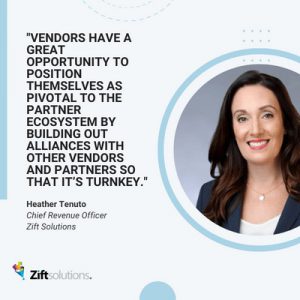 A frequent question that crops up is who is at the center of the ecosystem — the partner or the vendor? Despite being called a “partner” ecosystem, the partner is not at the center, nor is the vendor.
A frequent question that crops up is who is at the center of the ecosystem — the partner or the vendor? Despite being called a “partner” ecosystem, the partner is not at the center, nor is the vendor.
The diagram to the bottom right breaks down how customers, partners and vendors fit together in a partner ecosystem. The customer is at the center with partners encircling them to source multiple vendors and often other partners to meet business outcomes across the customer lifecycle. The vendor ring on the outside includes providers, which also are creating alliances with other vendors and partners to deliver more value to the customer throughout the lifecycle. As a result, the partner ecosystem looks more like a 3-D mesh network.
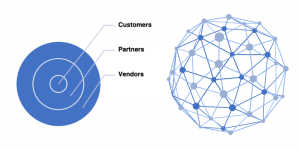 “While the customer must be at the center of the partner ecosystem, that doesn’t mean that they’re driving those relationships,” says BuzzTheory’s Henderson. “Partners have been building vendor ecosystems to meet customers’ needs for a long time. What’s different now is partners are orchestrating a more holistic solution across the customer lifecycle, from prospect to advocate. That’s an order of magnitude more valuable than simply connecting a customer with a single solution to meet a specific need at one point in time.”
“While the customer must be at the center of the partner ecosystem, that doesn’t mean that they’re driving those relationships,” says BuzzTheory’s Henderson. “Partners have been building vendor ecosystems to meet customers’ needs for a long time. What’s different now is partners are orchestrating a more holistic solution across the customer lifecycle, from prospect to advocate. That’s an order of magnitude more valuable than simply connecting a customer with a single solution to meet a specific need at one point in time.”
Zift Solutions’ Tenuto adds, “Vendors have a great opportunity to position themselves as pivotal to the partner ecosystem by building out alliances with other vendors and partners so that it’s turnkey. That means go-to-market plans, marketing materials and, if applicable, integrations. Vendors can take this a step further, helping to facilitate ecosystem relationships through a partner relationship management platform that helps them find partners or providers and enables multi-partner deal registration. ”
5 Reasons Channel Partner Programs Need Partner Ecosystems
Why should channel partner programs create a partner ecosystem? Our expert panel identified five key reasons.
1. Partner Ecosystems Foster Faster & More Effective Co-Marketing & Co-Selling
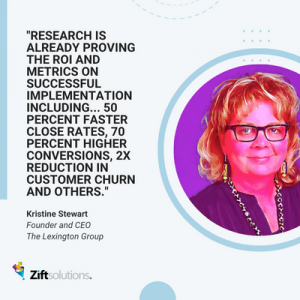 Our panel generally believes ecosystems will propel co-selling and co-marketing initiatives forward in effectiveness and speed to market. “You can have a richer set of co-marketing and co-selling opportunities with the right partners,” says The Lexington Group’s Stewart. “You can start to look at account mapping and collaborative selling and truly seeing the value in bringing together your sales and partner teams with those of the ‘right’ partners.”
Our panel generally believes ecosystems will propel co-selling and co-marketing initiatives forward in effectiveness and speed to market. “You can have a richer set of co-marketing and co-selling opportunities with the right partners,” says The Lexington Group’s Stewart. “You can start to look at account mapping and collaborative selling and truly seeing the value in bringing together your sales and partner teams with those of the ‘right’ partners.”
Plus, there are hard numbers to prove the value of the ecosystem. Stewart says, “Research is already proving the ROI and metrics on successful implementation including 30-40 higher ACVs [annual contract values], 50 percent faster close rates, 70 percent higher conversions, 2X reduction in customer churn and others.”
Co-selling and co-marketing partnerships aren’t limited to vendor-partner relationships. Suppliers can partner to bring a complete solution to market for partners and their customers. FMX Tech’s Fields explains: “[T]hese extra products and services can help drive more of a need for a provider’s product. Look at bandwidth providers partnering with a SaaS company. Selling a SaaS solution can increase the customer’s need for more bandwidth. As long as the SaaS solution runs smoothly over the network, it’s a win/win/win. A win for the customer, a win for the bandwidth provider and a win for the SaaS provider. It’s an ecosystem.”
2. Partner Ecosystems Present Another Route to Customers and More Sales
Partner ecosystems are designed to help vendors and their partners facilitate the sale of more solutions and services into customers’ environments.
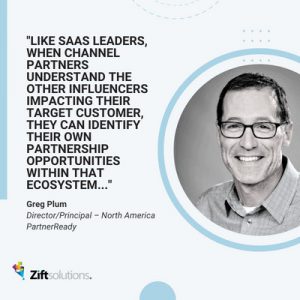 “SaaS leaders know that their success depends on identifying various routes to market to increase adoption within their target customers. Channel partners are but one route to market,” says PartnerReady’s Plum. “Like SaaS leaders, when channel partners understand the other influencers impacting their target customer, they can identify their own partnership opportunities within that ecosystem, thereby increasing their influence with their, now mutual, target customer.”
“SaaS leaders know that their success depends on identifying various routes to market to increase adoption within their target customers. Channel partners are but one route to market,” says PartnerReady’s Plum. “Like SaaS leaders, when channel partners understand the other influencers impacting their target customer, they can identify their own partnership opportunities within that ecosystem, thereby increasing their influence with their, now mutual, target customer.”
Vendors can help partners with opportunities in their regularly scheduled quarterly business review check-ins. Plum explains, “Once the ideal customer profile is identified, the channel partner should ask the following questions:
- What do they buy (in addition to my services)?
- How do they buy?
- Why do they buy?
- Who influences their decisions?
The answers to these questions will result in a list of potential routes to market for the channel partner to leverage.”
Karin Fields of FMX Tech adds that ecosystems are built based on customer needs. “Most partners today have their basic ecosystem for cabling, equipment, etc., that they have built over the years to support their customers,” she says. “Because customers are demanding more from their consultants, partners need to expand their ecosystems to include relationships with specialists in security, infrastructure, TEM, and much more.”
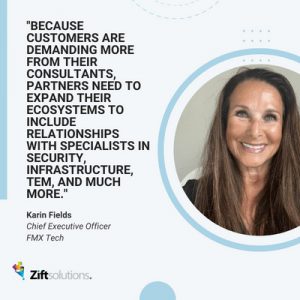 Fields also clarifies these sales opportunities aren’t limited to single-solution providers. “Even the major providers don’t offer everything that their customers are going to need,” Fields says. “If they don’t help their customers get access to those products and services, someone else will and that is opening the door for their competition.”
Fields also clarifies these sales opportunities aren’t limited to single-solution providers. “Even the major providers don’t offer everything that their customers are going to need,” Fields says. “If they don’t help their customers get access to those products and services, someone else will and that is opening the door for their competition.”
3. Partner Ecosystems Create More Complete Solutions Through Purpose-Built Integrations
Technology suppliers establishing integrations with other solutions isn’t a new trend, but the partner ecosystem can help facilitate more purposely engineered integrated solutions between two or more vendors, which can be co-marketed into existing and prospective customer accounts.
Appgate’s Prazak argues that plug-and-play integrations help vendors and their partners capitalize on the ecosystem model. “As providers broaden their channel partnership ecosystem and offer more through marketplaces, having an API-driven solution that easily enables your technology to be integrated with other solutions or existing tools in your customer’s current technology stack is key,” Prazak says.
Prazak also says that new ecosystem models may require competitors to put aside their grievances and work together to claim a lucrative deal a partner presents them. “Letting go of the old way of doing business, in this new model, [and] being open to ‘coopetition’ and aligning with companies who were previously foes can lead to a winning approach,” she says.
4. Partner Ecosystems Integrate the Partner Program with the Provider Company
It’s no secret that for those companies that don’t have 100 percent channel-only sales models, the channel is generally separated from the rest of the organization and, in some ways, appears to function like a separate business.
“Channel organizations (across all industries) have been somewhat siloed over the past 40 years, including having their own built-in channel marketing, sales, operations and finance groups,” Canalys’ McBain says. “In fact, the Harvard Business Review concluded that successful channel chiefs have skills more in common with a CEO or general manager than a line of business leader like the head of sales or marketing.”
Ecosystems can help mend this separation and create a company-wide holistic approach to growing the indirect sales channel.
McBain explains: “These new ecosystem chiefs are looking to run technology alliances, strategic alliances, business alliances, influence channels, transaction and transaction-assist channels, and retention channels in parallel. Instead of building an empire of people siloed from the rest of the company under these six partner models/motions, they are embedding partner professionals in marketing, sales, customer success, product and strategy groups. This ‘dotted-line’ approach to channel leadership looks more akin to data science (embedded in every department and indirectly reporting to a central CTO) than it does to previous incarnations of indirect sales departments.”
5. Partner Ecosystems Improve Partner Experience (PX)
The quality of your program’s partner experience will be significantly enhanced when you adopt an ecosystem model. “Done correctly, the partner experience should be improved from several aspects,” says The Lexington Group’s Stewart. [The] key is helping their businesses grow and this can be done because you are providing them opportunities within your vendor solution for them to insert their own services and solutions. They also can leverage other ecosystem partnerships you have that can improve their total solution.”
Partners can also take advantage of multiple vendors’ incentive programs and MDF at once. Stewart reminds providers that these offers to partners should be coordinated between vendors in the ecosystem. “[Y]ou should be updating incentives and how they utilize joint funds within your programs,” she says.
With all this in mind, it’s apparent that developing a thriving partner ecosystem is the next logical step for any established partner program looking to maximize its ROI.




